And again the weapons of the Philadelphia Museum
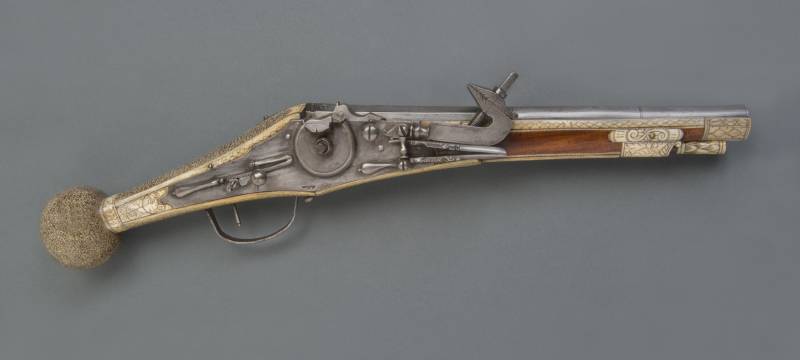
Pistol with wheel lock 1590. Made in Nuremberg. Engraved deer antler inlay, blued steel lock, engraved steel barrel. Length 56,5 cm, weight 2 g. Caliber: 074,2 millimeters. Donated to the museum by the will of Karl Otto Kretschmar von Kienbusch, 15
Military museums of the world. We have already managed to visit the Philadelphia Museum of Art and get acquainted with their collection of armor and helmets. However, it is so vast that last time we saw only part of it.
However, today we will also see only a fragment, but very, very interesting.
Armor
First of all, let's look at this armor - dating back to the New Age, when chivalry still continued to exist, but degenerated literally before our eyes. This is armor for a foot tournament or "duel through the barrier."
This armor was made in 1590 by Pompeo della Cesa, who worked in Milan around 1537-1610. This armor was used in a very original tournament, designed to protect its participants as much as possible, since the rivals in it were separated by a wooden barrier that reached them to the waist. It was necessary to fight either with a pike or with a sword. And since the barrier provided complete protection for the lower body, this type of armor only protected the upper torso.
The armor was made of steel and finished with engraving, etching, partially blackening and gilding. Brass was also used for its decoration, details of the armor were lined from the inside with leather.
The dimensions of this armor are as follows: the height from the top of the helmet to the fingertips of the gloves is 92 cm. The height from the top of the helmet to the bottom of the breastplate is 80 cm. The width at the shoulders is 51 cm. The weight of the armor is 14,51 kg.
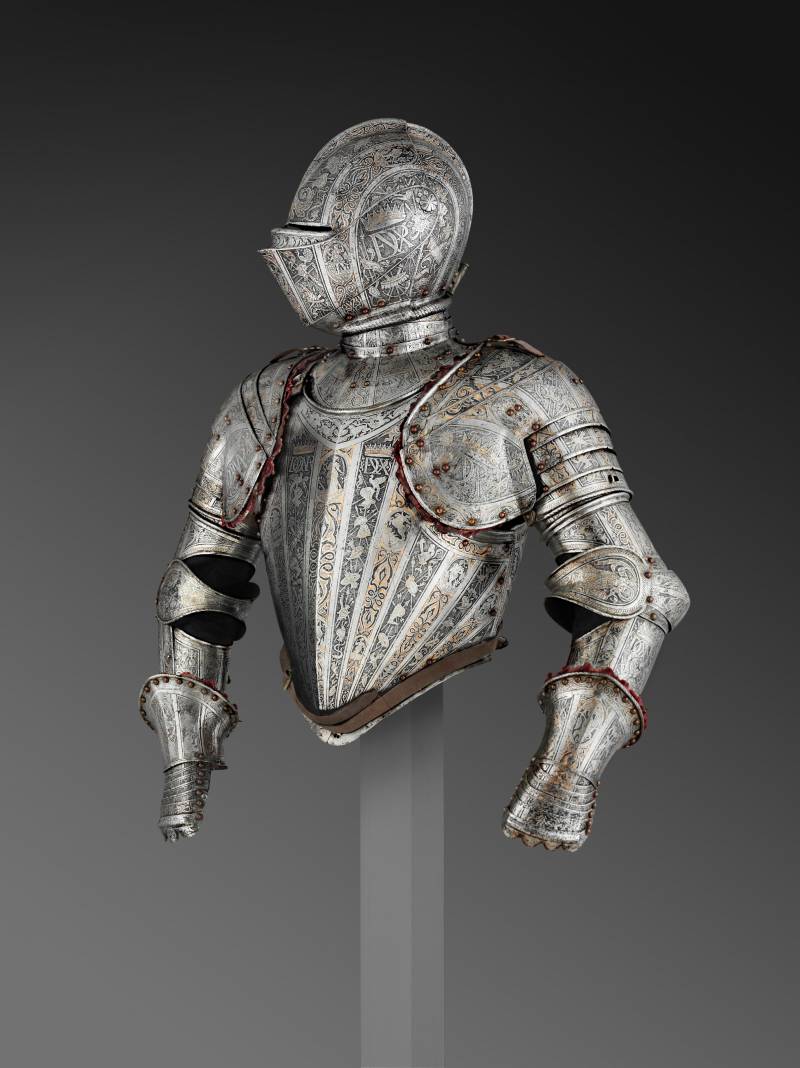
Armor in all its glory!
Full field armor for a rider and a horse is another fine example of a horseman's armament from the early 1505th century. The armor for the rider was made in 1485 by the gunsmith Matthes Deutsch from Landshut, the first mention of which dates back to 1505, and the last documented in XNUMX.
This armor is one of the few complete or sufficiently complete European field armor that has survived from that time. It is also the richest, last and most complete surviving work of Matthes Deutsch, a successful gunsmith who lived in the Bavarian ducal residence of Landshut. Stripes running around the edges and down the center of the breastplate show engraved and gilded flowers and foliage against a dark blued surface.
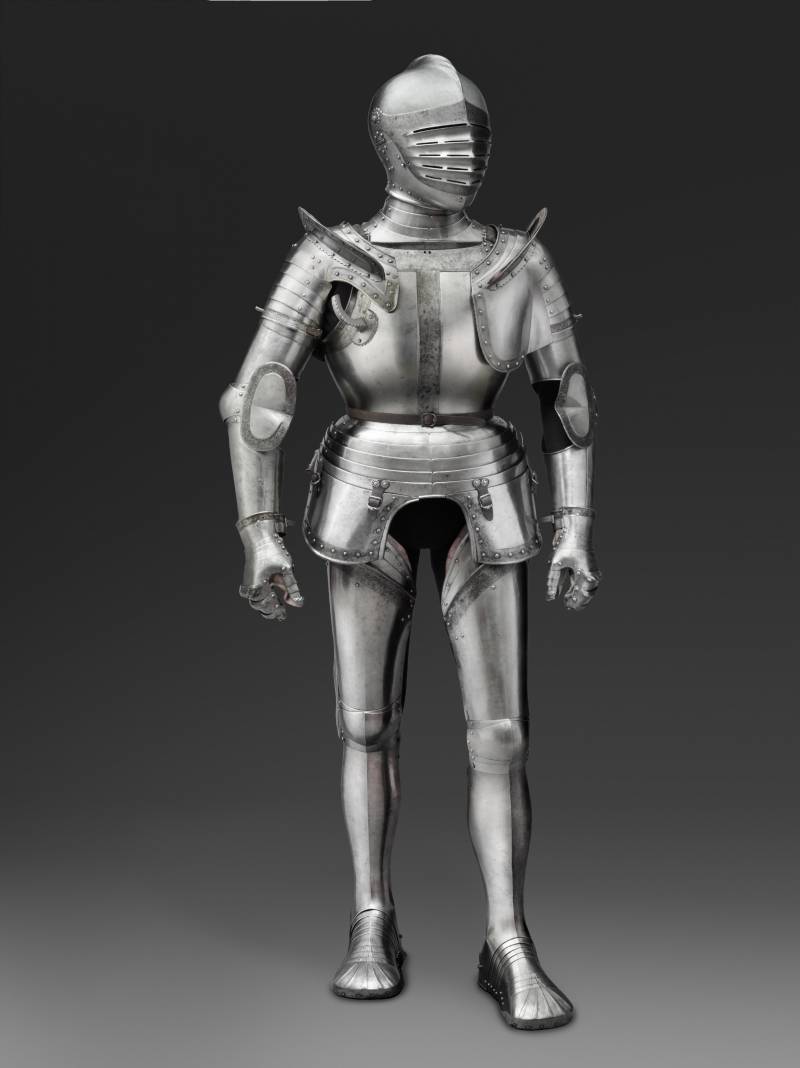
Armor in full growth. The functionality of the previous century has not yet been lost, but the armor is already beginning to decorate a little ...
Materials are pickled and partially blued and gilded steel; as well as leather and textiles. The height of the owner, judging by the armor, was 190 cm, and the armor weighed 26,54 kg.
As for the horse armor, they are not native, but were made for Duke Ulrich of Württemberg when he was twenty years old. They were made for an important event - a trip that he planned to make with Emperor Maximilian I of Austria to Rome, where Maximilian was to be crowned Emperor of the Holy Roman Empire. They protected the horse and showed the duke's wealth and status, as only high-ranking nobles could afford such fine armor.
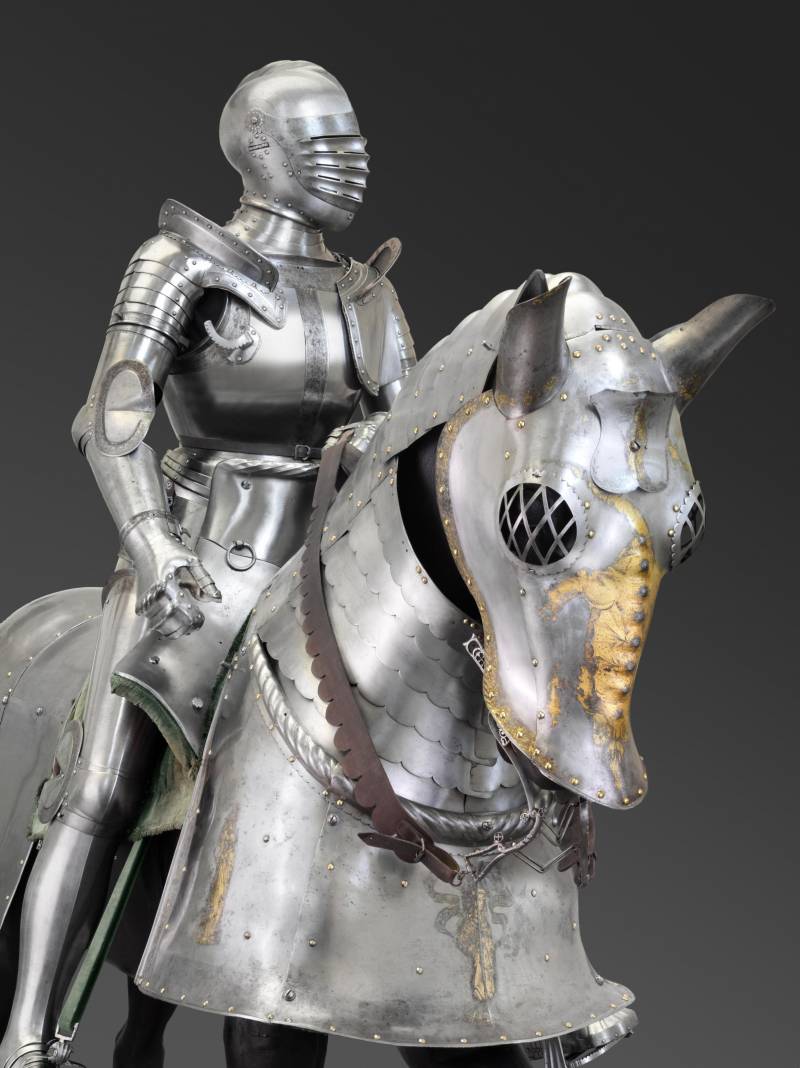
Armored rider on horseback. On saffron golden dragon!
Its decoration also conveys important messages: a golden-winged dragon on a saffron (horse headdress) demonstrates ferocity, and elegant women holding banners with the Duke's personal motto emphasized his own importance, since the literal translation of the motto meant: "I can do what I set out to do." do".
This horse armor is extremely rare because it is one of the earliest such armor in the world at all. And besides, it has never been taken apart for all this time. The armor was donated to the museum by Athena and Nicholas Karabots and the Karabot Foundation in 2009.
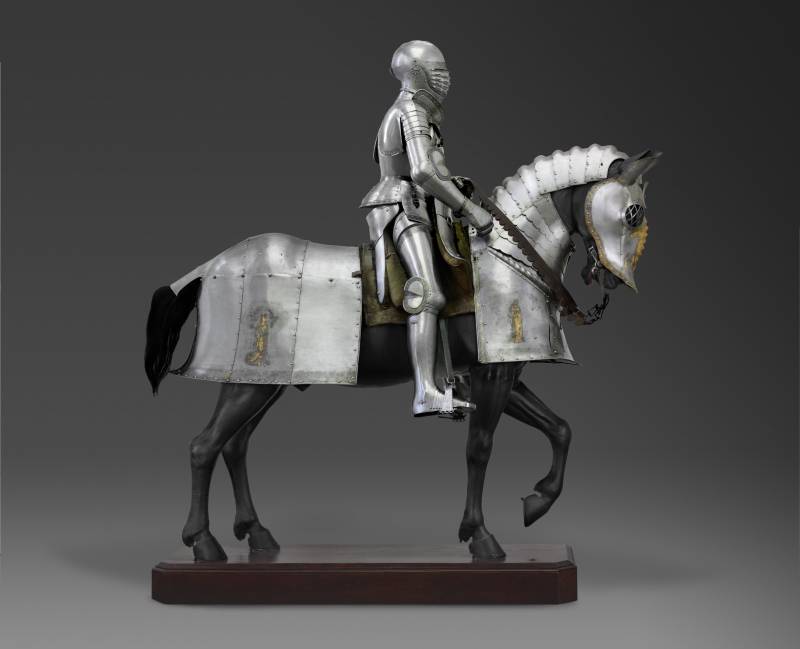
Side view of the armor. Moreover, it must be emphasized that the horse's neck is protected not only from above, but also from the front, so that the armor is integral with the breastplate. That is, it was a well-thought-out defense against pikemen, and not just something that served only to demonstrate adherence to traditions and one's wealth!
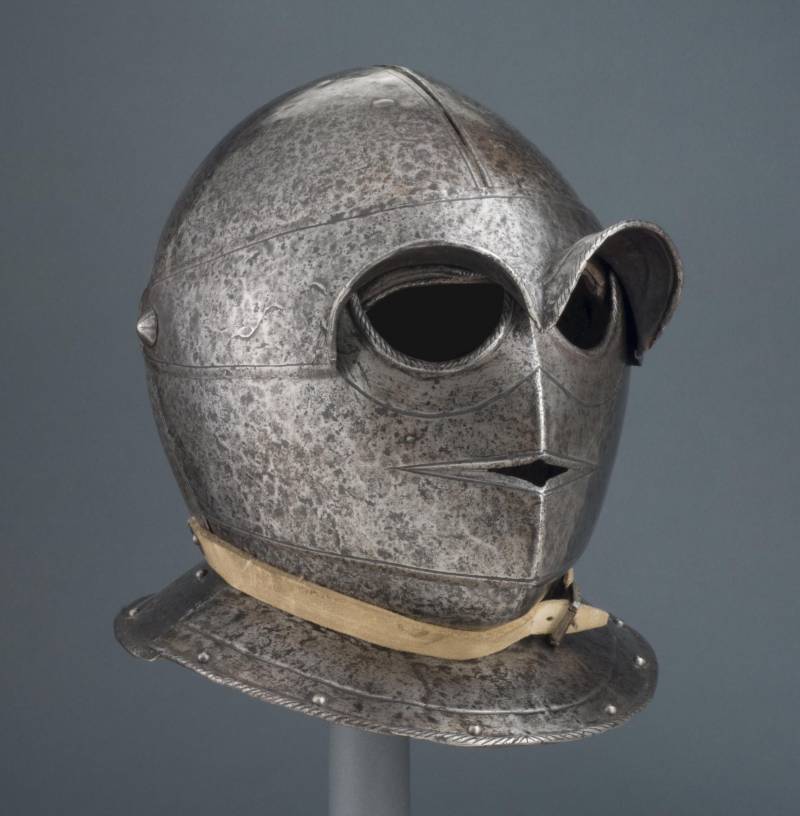
Bourguignot helmet
The action of the novel by A. Dumas "The Three Musketeers" begins in 1628, and the musketeers themselves do not wear armor there. However, this does not mean that at that time no one, except perhaps Cardinal Richelieu, used them. On the contrary, equestrian armor was used, and very widely.
For example, helmets of the burgignot or burgonet type, one of which, made in Italy in 1600-1620, could well have been used at the time described in the novel. He certainly looks a little creepy. real face Robot (who would have thought?!), by the way, and his weight is very decent - 5,35 kg. Donation by Carl Otto Kretschmar von Kienbusch, 1977
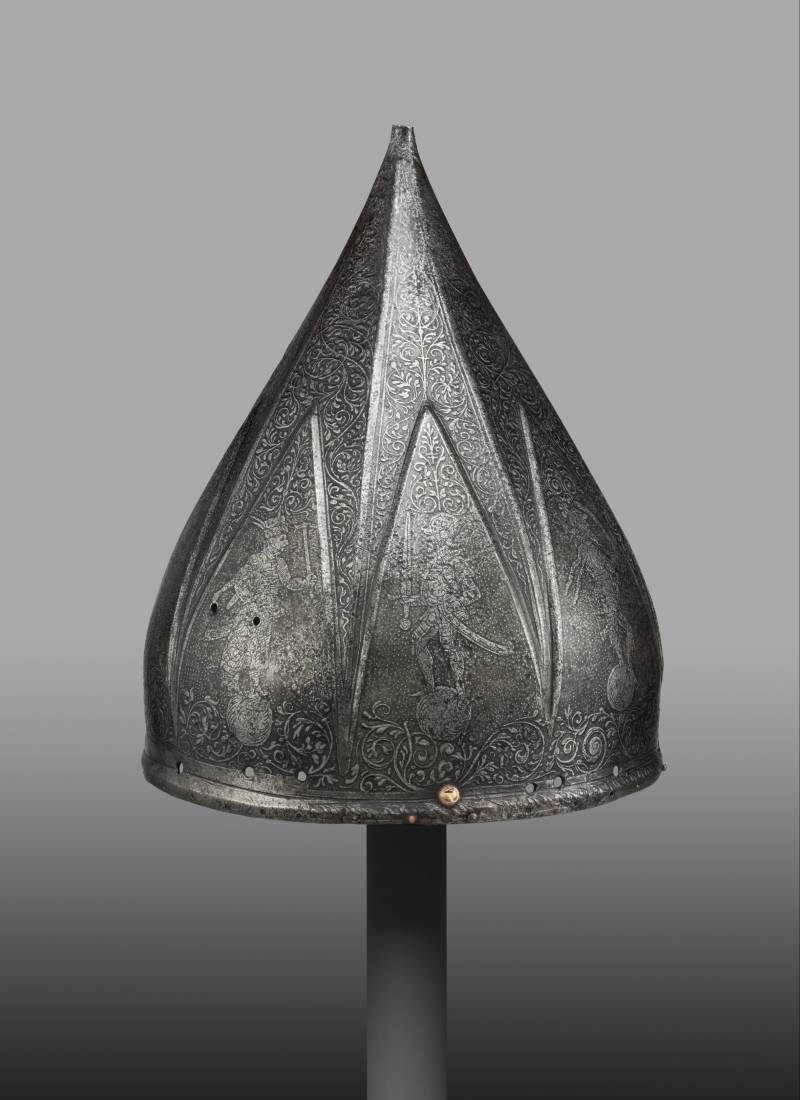
Shishak 1550 from Nuremberg
Another helmet in the museum's collection is interesting for its decorative images. This is a helmet-shishak approx. 1550, made by an unknown master from Nuremberg. Moreover, this is a military trophy from the former arsenal of the Ottoman sultans in the former church of St. Irene in Constantinople, present-day Istanbul. A full helmet was to consist of a bowl, cheekpieces and nape protection, decorated in accordance with the general design concept. But these details, alas, are not.
Interestingly, helmets of this type were mass-produced in Germany for export to Eastern Europe, and, of course, they also ended up in Turkey. Weight: 1 g. Donation by Karl Otto Kretschmar von Kienbusch, 195.
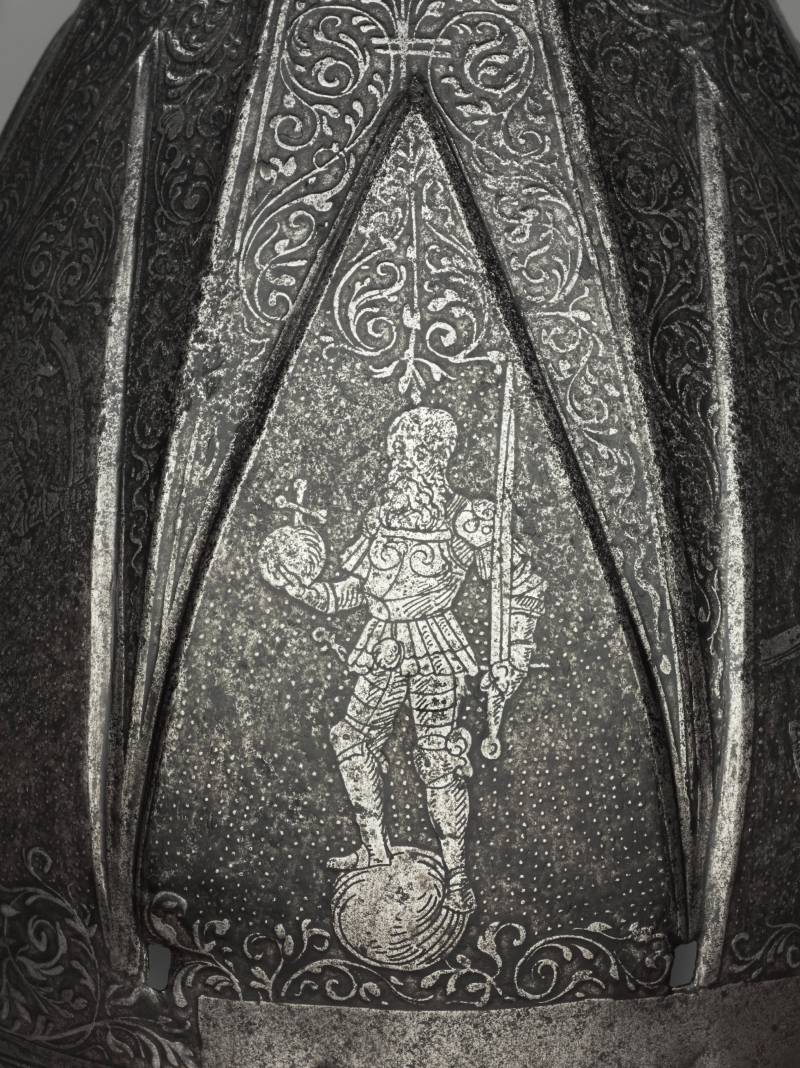
This triangle depicts a warrior, clearly a Christian
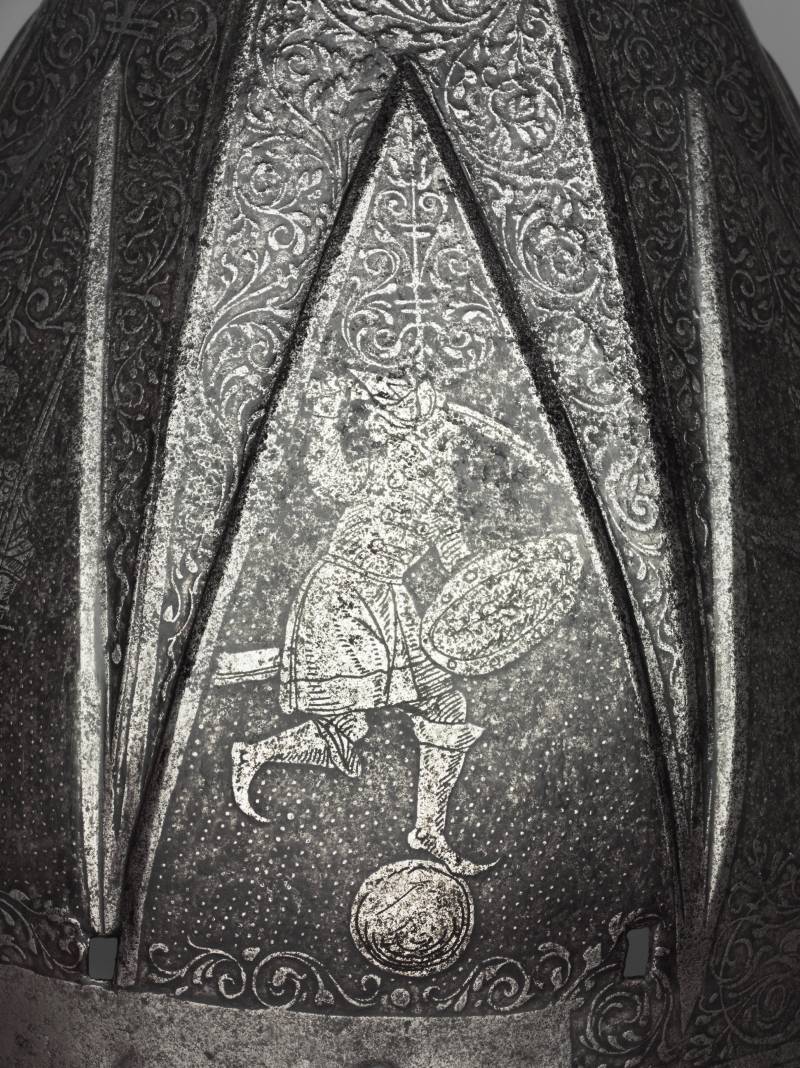
And here, most likely, the Osman is depicted
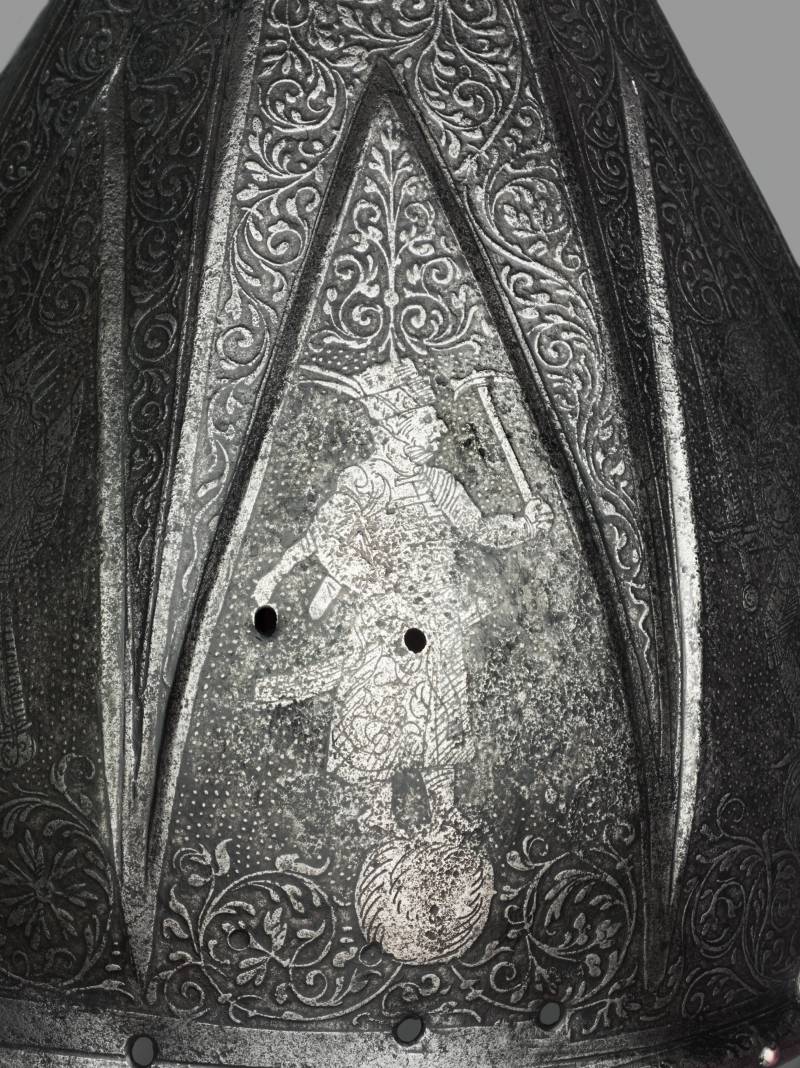
The last is, apparently, a Pole or a Hungarian. That is, the helmet is designed in a highly international way!
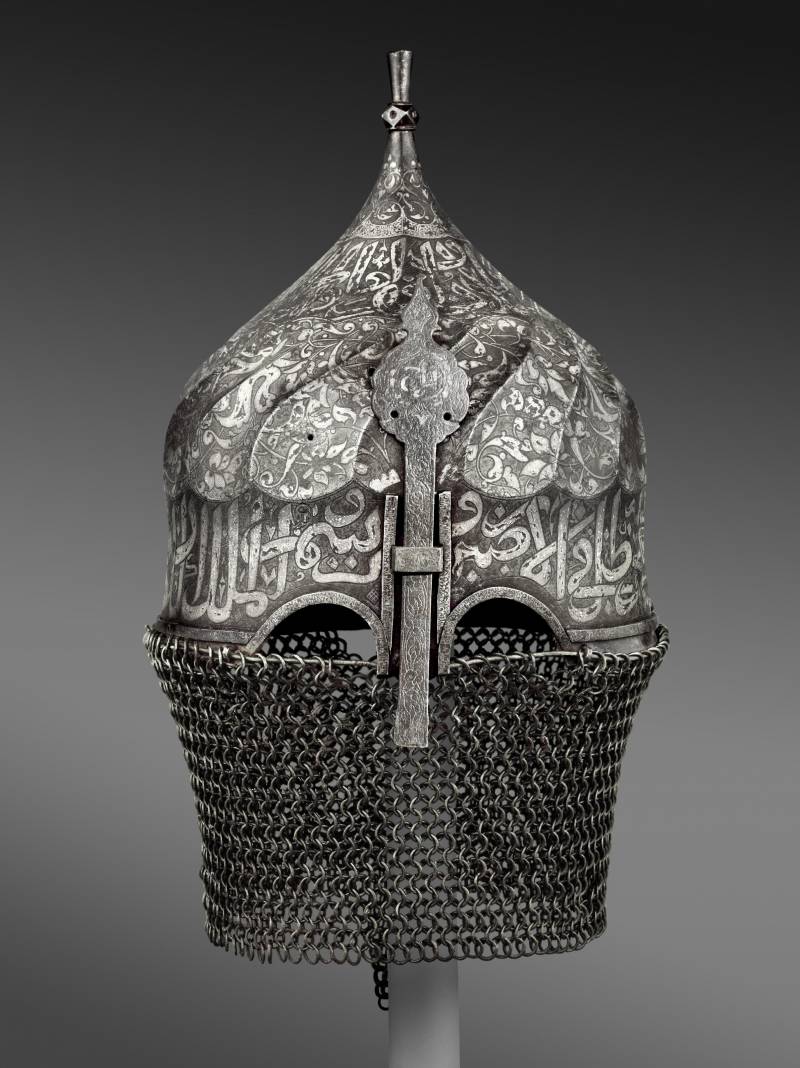
The turban helmet is also in the museum's collection, and it dates back to 1475-1525.
The master who made it is unknown, but it is clear that it was made somewhere in the Middle East. The inscription in Arabic reads: "Made by order of the greatest sultan, the most powerful khakan, the ruler of the peoples, the ruler of the kings of the Arabs and Persians, the shadow of Allah on earth." This is a war trophy from the former arsenal of the Ottoman sultans in the former church of Hagia Irene, Constantinople (now Istanbul).
The material this helmet is made of is steel. Decorated with engraving and silver coating. The total weight is 2 g. Donation by Carl Otto Kretschmar von Kienbusch, 730.
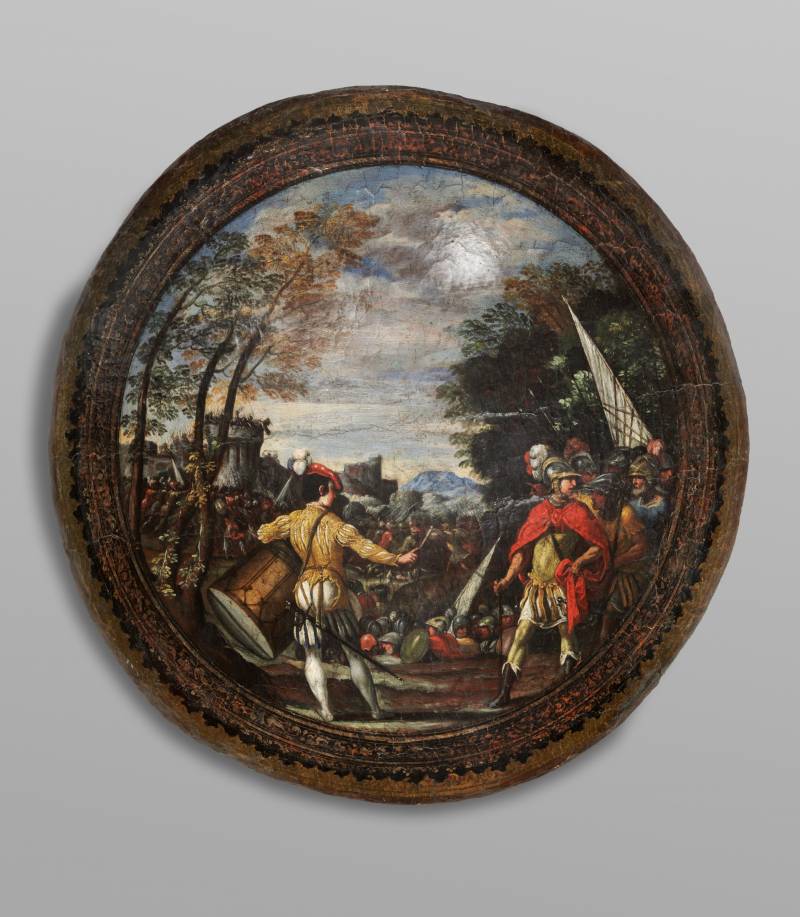
front shield. A very strange product, isn't it?
Well, it would be nice if this shield was metal and suited to some kind of armor. And here - the shield itself is wooden, covered with a plaster primer and colorfully painted. It is difficult to assume that some equally painted armor existed for him. That is, the armor was on its own, and the shield was on its own, but they wore it with armor, at least along with the morion helmet. Made in 1550–1570. in Italy. Diameter 64,7 cm. Weight 2 g.
Steel arms
Finally, we got to cold weapons.
And the first sample of it we will have is this rapier, around 1590-1610. The blade was made by blacksmith Clemens Meigen from Solingen.
Interestingly, the blade of the rapier is perforated, partially blackened and gilded; the handle is trimmed with brass wire; iron wire; and also copper. Length (total): 120,5 cm. Blade length - 103,6 cm. Donation by Karl Otto Kretschmar von Kienbusch, 1977.
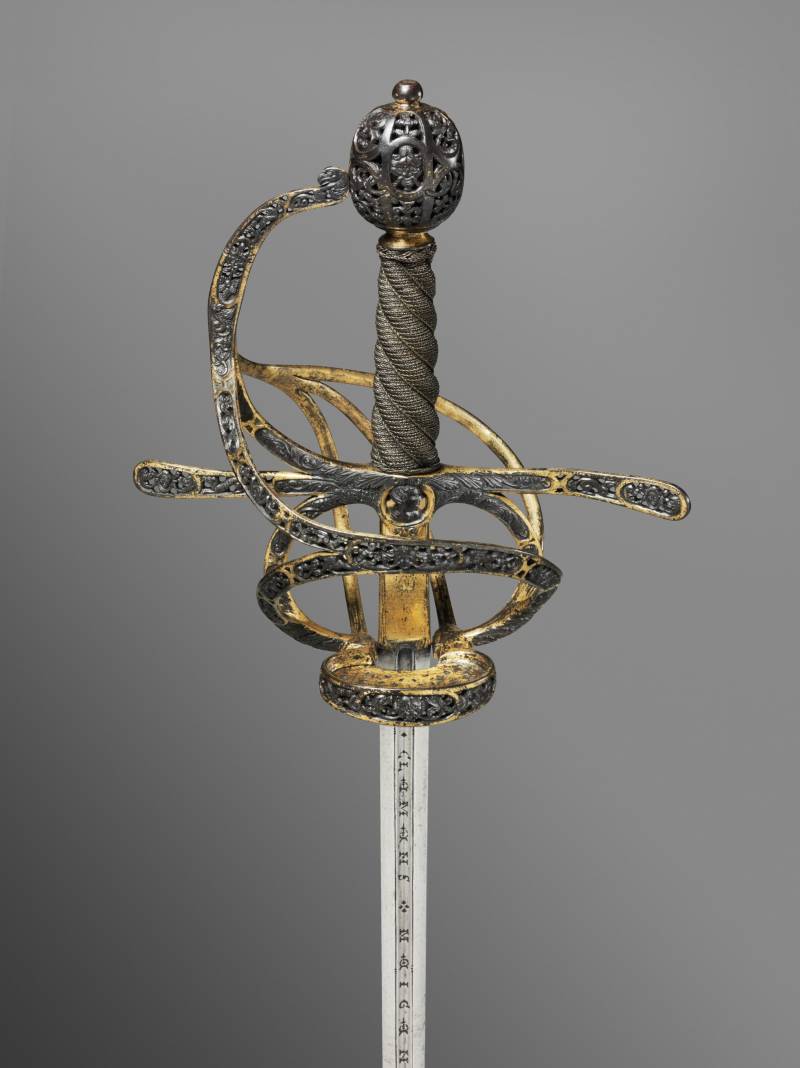
Rapier Clemens Meigen from Solingen. Handle
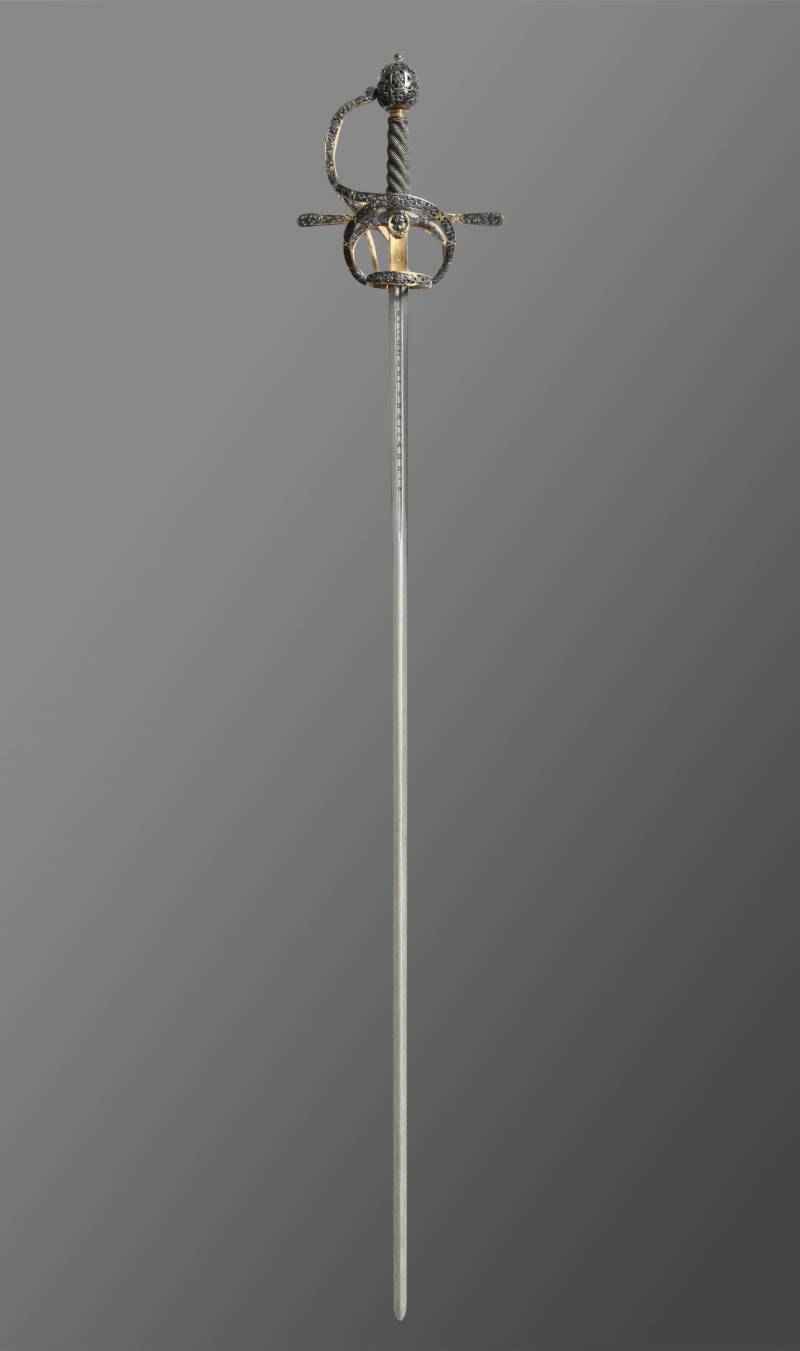
The entire rapier. Very long, isn't it?
Horseman's sword 1599. This sword is one of eleven swords that were in the Saxon arsenal in 1606. Blade - pickled and partially blued steel; guard - etched and partially blackened iron; handle - wood, fish skin. Donation by Karl Otto Kretschmar von Kienbusch, 1977

Here it is, this sword. With such swords, and in fact, heavy rapiers, the cavalry of the reiters and cuirassiers were armed, who with their help completed the defeat of the infantry, upset by their pistol fire
Well, that seems to be all for today.
That is, the weapons collection of the Philadelphia Museum of Art, of course, did not end there, but we still have many museums to visit, so we will probably stop at these exhibits.
Information